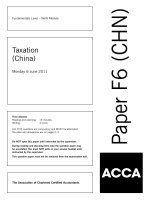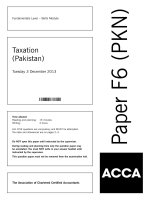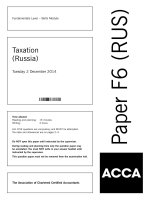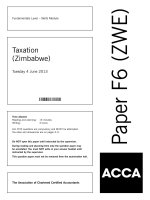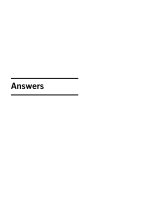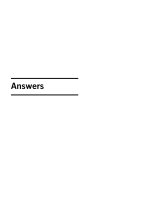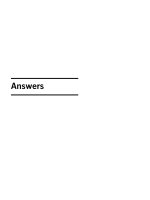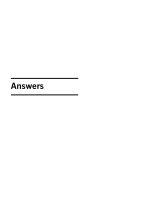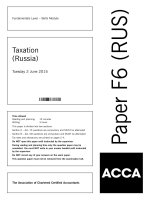ACCA f6 taxation singapore 2014 jun question
Bạn đang xem bản rút gọn của tài liệu. Xem và tải ngay bản đầy đủ của tài liệu tại đây (241.7 KB, 12 trang )
Taxation
(Singapore)
Tuesday 3 June 2014
Time allowed
Reading and planning:
Writing:
15 minutes
3 hours
ALL FIVE questions are compulsory and MUST be attempted.
Tax rates and allowances are printed on pages 2–4.
Do NOT open this paper until instructed by the supervisor.
During reading and planning time only the question paper may
be annotated. You must NOT write in your answer booklet until
instructed by the supervisor.
This question paper must not be removed from the examination hall.
The Association of Chartered Certified Accountants
Paper F6 (SGP)
Fundamentals Level – Skills Module
SUPPLEMENTARY INSTRUCTIONS
1. Calculations and workings need only be made to the nearest $.
2. All apportionments should be made to the nearest month.
3. All workings should be shown.
4. All computations should indicate by the use of ‘0’ any item of income or expense which is tax exempt, not taxable
or does not require adjustment, as appropriate.
TAX RATES AND ALLOWANCES
The following tax rates and allowances are to be used in answering the questions
Goods and services tax
Standard rate
Registration threshold
7%
$1 million
Corporate income tax
Year of assessment 2014 – rate
17%
Corporate tax rebate (capped at $30,000)
30%
Partial tax exemption
$
7,500
145,000
–––––––––
152,500
–––––––––
First $10,000 of chargeable income is 75% exempt
Next $290,000 of chargeable income is 50% exempt
Total
Full tax exemption for new start-up companies
$
100,000
100,000
–––––––––
200,000
–––––––––
First $100,000 of chargeable income is 100% exempt
Next $200,000 of chargeable income is 50% exempt
Total
Central Provident Fund (CPF)
Contributions for individuals below the age of 50 years and earning more than $1,500 per month
Employee
20%
Rates of CPF contributions
Maximum monthly ordinary wages (OW) attracting CPF
For the year 2013 (i.e. from 1 January 2013 to 31 December 2013)
Maximum annual ordinary wages (OW) attracting CPF
Maximum annual additional wages (AW) attracting CPF
–
–
Employer
16%
$5,000
$60,000
$85,000 less OW subject to CPF
Productivity and Innovation Credit (PIC) –
years of assessment 2013 to 2015
Training (enhanced deduction)
Prescribed automation equipment (enhanced capital allowance)
An enhanced deduction/allowance can be claimed at 300% on up to $400,000 of qualifying expenditure in addition
to the usual deduction/allowance.
The annual expenditure cap of $400,000 can be pooled to give a combined cap of $1,200,000 for the years of
assessment 2013 to 2015.
2
Personal income tax for the year of assessment 2014
Chargeable income
$
20,000
10,000
–––––––––
30,000
10,000
–––––––––
40,000
40,000
–––––––––
80,000
40,000
–––––––––
120,000
40,000
–––––––––
160,000
40,000
–––––––––
200,000
120,000
–––––––––
320,000
320,000
On the first
On the next
On the first
On the next
On the first
On the next
On the first
On the next
On the first
On the next
On the first
On the next
On the first
On the next
On the first
Above
Tax rate
%
0
2·0
Tax
$
0
200
–––––––
200
350
–––––––
550
2,800
–––––––
3,350
4,600
–––––––
7,950
6,000
–––––––
13,950
6,800
–––––––
20,750
21,600
–––––––
42,350
3·5
7·0
11·5
15·0
17·0
18·0
20·0
Personal income tax reliefs for the year of assessment 2014
Earned income
Below 55 years
55 to 59 years
60 years and above
Normal (max)
$1,000
$6,000
$8,000
Spouse relief
Handicapped spouse relief
Handicapped (max)
$4,000
$10,000
$12,000
$2,000 (max)
$3,500 (max)
Qualifying child relief (per child)
Handicapped child relief (per child)
$4,000
$5,500
Working mother’s child relief (WMCR)
First child
Second child
Third and subsequent child
% of mother’s earned income
15%
20%
25%
Maximum WMCR
Maximum relief per child
100%
$50,000
Parent relief
Not living in the same household
Living in the same household
$4,500
$7,000
Handicapped parent relief
Not living in the same household
Living in the same household
$8,000
$11,000
Grandparent caregiver relief
$3,000
Life assurance
$5,000 (max)
Voluntary CPF contribution of self-employed
Capped at $30,600 or 36% of assessable
trade income whichever is lower
Course fees
$5,500 (max)
3
[P.T.O.
NSman
Normal appointment
holder
$3,000
$1,500
$750
Active NSman
Non-active NSman
Wife/widow/parent of NSman
Foreign maid levy
$6,360 (max)
4
Key appointment
holder
$5,000
$3,500
$750
This is a blank page.
Question 1 begins on page 6.
5
[P.T.O.
ALL FIVE questions are compulsory and MUST be attempted
1
Slimming Industries Pte Ltd (SIPL) manufactures slimming pills and teas. For the year ended 31 December 2013,
SIPL made a net accounting profit of $5,000,000 before income tax. The following items were charged/(credited) to
the profit and loss account in arriving at the net accounting profit:
$
Dividend income received from shares in Best Fit Ltd in Country B, a tax haven. There was no
corporate or withholding tax suffered on this dividend income and the funds were used to repay
a supplier in Hong Kong in August 2013
Insurance recovery of loss of profits as a result of the bad publicity relating to SIPL’s slimming
pills
Realised exchange gain on the repayment of a loan taken out to fund the investment in
Best Fit Ltd
Scrap value of a machine. At the time of sale, both the net book value and tax written down
value of this machine was nil
Cash donation to a building fund for a temple in Myanmar
Cash donation to the National Kidney Foundation
Compensation paid to customers who experienced serious discomforts after consuming the
slimming pills
Corporate secretarial charge
Depreciation
Due diligence fee on the acquisition of the spa division of Wellness Pte Ltd
Hire purchase interest for the lorry acquired during the year
Insurance premium – workman compensation
Interest expense on a loan taken to fund the investment in Best Fit Ltd
Late payment interest on the late payment of CPF contributions
Legal fees – insurance recovery for loss of profits
Legal fees – new tenancy agreement for a spa outlet
Loan to a staff member written off
Medical expenses reimbursed to customers who consumed the slimming pills
Penalty for the late filing of CPF contributions
Personal income tax liability of SIPL’s managing director borne by SIPL in accordance with the
terms of his employment
Retrenchment benefits paid to staff following the closure of the slimming pills division
Staff costs – salary, bonus and CPF contributions (75% of the staff strength of 200 are local
employees)
Staff medical expenses (SIPL has implemented a portable medical insurance scheme for its staff)
Write off of all slimming pills in stock
(20,000)
(10,000)
(2,000)
(1,200)
3,000
5,000
250,000
300
20,000
30,000
3,120
2,000
5,000
1,000
3,000
5,000
6,000
50,000
500
15,000
50,000
250,000
6,000
60,000
SIPL acquired the following assets in the financial year ended 31 December 2013.
1.
A lorry purchased on hire-purchase on the following terms:
Cash price
Deposit paid on 1 June 2013
Amount of each monthly instalment (including interest on a straight line basis). The first
of 24 monthly payments was made on 1 July 2013
$130,000
$26,000
2.
Computer system
$150,000
3.
Eight desks
$4,853
$7,200
SIPL claimed the maximum productivity and innovation credit (PIC) cash payout on 30 June 2013 and has not made
any PIC claims previously.
6
Required:
(a) Explain the tax treatment of the monthly instalments paid in respect of the lorry acquired on hire purchase
and calculate the qualifying expenditure incurred for a capital allowances claim for the year of assessment
2014.
(2 marks)
(b) Compute the minimum tax liability of Slimming Industries Pte Ltd (SIPL) for the year of assessment 2014
and clearly identify all applicable productivity and innovation credit (PIC) claims.
Note: You should start your computation with the net accounting profit of $5,000,000 and indicate by the
use of zero (0) any items which do not require adjustment.
(27 marks)
(c) State the date by which SIPL must file its tax return (Form C) for the year of assessment 2014.
(1 mark)
(30 marks)
7
[P.T.O.
2
(a) Benson Lim, an active, non-key appointment holder national serviceman, is 38 years old and a divorcee. He
pays monthly alimony of $3,000 to his ex-wife. Following the divorce, Benson was awarded custody of his
six-year-old twins, Annie and Anderson, and hired a Filipino maid to look after the twins. In addition, Benson’s
mother, a retired teacher, who has rental income of $2,000 per month, lives with him and helps look after the
twins.
Benson is a successful fund manager. On 1 January 2013, he joined Alpha Fund under the following
employment terms:
(i)
Joining fee – upon joining Alpha Fund he was paid $60,000. Should he leave Alpha Fund within two years,
Benson will have to repay part of this joining fee.
(ii) Salary – $30,000 per month.
(iii) Fixed bonus – one month’s salary, payable in January of the following year.
(iv) Variable bonus – this bonus is calculated by reference to the performance of the portfolio under his charge
and is decided upon in March of the following year. Benson’s portfolio performed well in 2013 and he was
paid a variable bonus for 2013 of $100,000 on 1 April 2014.
(v) Entertainment allowance – $3,000 per month. An estimated 80% of this allowance was expended on
entertaining business clients.
(vi) Rent free accommodation – an apartment which was rented by his employer at a monthly rental of $5,000.
(vii) Use of a company car – the cost of the new car was $200,000 inclusive of COE of $80,000 and its
estimated residual value is $50,000. Benson’s total mileage for the year 2013 was 22,000 km, 80% of
which were for business purposes. His employer paid all the running expenses of the car.
Benson also had the following other income in the year 2013:
(i)
Director’s fees from Arc Co Ltd of $18,000 for the year ended 31 December 2012 and $28,000 for the
year ended 31 December 2013, which were approved for payment at the company’s annual general
meetings on 31 March 2013 and 31 March 2014 respectively. Arc Co Ltd is a family owned company and
Benson was appointed as a non-executive director in 2010.
(ii) Interest income of $5,000 from a personal loan extended to Melvin, an Australian national and tax resident,
for the expansion of Melvin’s fund management business in Australia. Benson remitted this interest to his
Singapore bank account in June 2013.
(iii) A gain of $100,000 from the sale of his wine and liquor collection. Benson decided to sell his collection for
personal medical reasons.
Required:
(i)
Compute the minimum tax payable by Benson Lim for the year of assessment 2014, indicating by the
use of zero (0) any items which do not require adjustment.
(18 marks)
(ii) Explain your tax treatment of the gain of $100,000 from the sale of Benson’s wine and liquor collection.
(2 marks)
8
(b) Beatrice set up a sole proprietorship business to provide consultancy services on 1 October 2011 and adopted
31 December as her business accounting year end. The following expenses were charged to the profit and loss
statement of Beatrice’s business for the periods indicated:
Period
1 October 2011 to 31 December 2011
1 January 2012 to 31 December 2012
1 January 2013 to 31 December 2013
Expense
Wages of a part-time employee
Registration cost with the Accounting and
Corporate Regulatory Authority (ACRA)
Rental of shop
Legal fee for the purchase of a new office
$
2,000
500
10,000
3,000
Beatrice secured her first contract for $10,000 in January 2013.
Required:
(i)
State the date of commencement of Beatrice’s business for tax purposes.
(ii) State, giving reasons, whether each of the expense items listed is or is not tax deductible.
(1 mark)
(4 marks)
(25 marks)
9
[P.T.O.
3
(a) List any THREE items of information which must be present on a tax invoice for the purposes of goods and
service tax (GST) which are not required on a non-GST registered trader’s invoice.
(3 marks)
(b) Compare and contrast the treatment of a zero rated supply and an exempt supply for the purposes of GST.
(4 marks)
(c) The following four scenarios should be addressed independently.
Scenario 1:
Nice Home Pte Ltd, a GST registered person, expended $1·07 million (including GST) on the purchase of kitchen
and bathroom fittings to fit out its latest residential development, an executive condominium project. The project
was sold for a total sum of $400 million.
Scenario 2:
Orange Pte Ltd, a GST registered person, hired a motor car for $64,200 (including GST) for 12 months in 2013.
The motor car was used by the company’s sales manager exclusively for business purposes.
Scenario 3:
Petra Pte Ltd (PPL), a GST registered person, set up a branch in Brunei. PPL signed a $1 million contract with
a Singapore incorporated company, Sharp Pte Ltd (SPL), for the work to be performed in Brunei. The work in
Brunei will be performed by employees of SPL’s Brunei branch.
Scenario 4:
Peter, the sole proprietor of Grocery Fresh, is a GST registered trader. Peter has supplied his family with free
groceries from Grocery Fresh on a regular basis. In the last quarter, these free supplies to his family had a cost
of $2,000.
Required:
(i)
In respect of Scenarios 1 and 2, state, with reasons, whether output tax needs to be accounted for and
input tax credit can be claimed.
(4 marks)
(ii) In respect of Scenarios 3 and 4, state, with reasons, whether output tax needs to be accounted for and
if so, the amount of the output tax.
(4 marks)
(15 marks)
10
4
Patrick Chan is the new chief financial officer of P-Star Pte Ltd (P-Star), a company incorporated and tax resident in
Singapore. Patrick has conducted a review of P-Star’s tax filings for the year of assessment 2013 and discovered the
following:
(i)
All of P-Star’s employees are entitled to a meal allowance for working overtime in addition to their fixed meal
allowance. The fixed monthly meal allowance had been reported in the employees’ Form IR 8A but the meal
allowance for ad hoc overtime was not reported.
(ii) P-Star maintains a liaison office in India for the purpose of promoting the sales of its products in India. P-Star
has not claimed a tax deduction for the total operating cost of $100,000 incurred in maintaining this office.
(iii) P-Star received branch profits repatriated from its Hong Kong branch. These profits have been taxed in Hong Kong
at its profits tax rate of 16·5%. P-Star has not included these profits in its Singapore tax computation.
(iv) P-Star paid a contractor $8,000 to install a base to run the cables and trunking required for the installation of a
computer system. Capital allowances have been claimed on the installation cost of $8,000.
(v) P-Star donated $2,000 to an institution of public character (IPC) in return for the space to place a banner
promoting P-Star’s new products at a charitable event organised by the IPC. The IPC usually charges its
customers $1,500 for the use of such space. P-Star has claimed a tax deduction of $5,000 (being 2·5 times
$2,000) for this donation.
(vi) P-Star paid a licence fee of $5,000 to Arthur Ltd, a company incorporated and tax resident in Country A, for the
use of its brand name in Singapore. There is no double taxation agreement between Singapore and Country A.
P-Star has not accounted for any Singapore withholding tax on the licence payment.
Required:
(a) For items (i) to (iv), state, giving reasons, whether the actions taken by P-Star Pte Ltd (P-Star) are correct.
(8 marks)
(b) For item (v), explain why the action taken by P-Star is incorrect and quantify the amount of the actual tax
deduction (if any) available.
(3 marks)
(c) For item (vi), state, giving reasons, whether tax should have been withheld from the licence fee payment and
if so, the consequences for P-Star of not doing so.
(4 marks)
(15 marks)
11
[P.T.O.
5
Zar and Annie are partners in the ZNA partnership, which provides interior design services in Singapore. They have
agreed to share the partnership profits and losses equally.
The net accounting profit of ZNA for the year ended 31 October 2013 is $123,000 after charging/crediting the
following items:
Expenses
(1) Reimbursement of the petrol and parking charges of $10,000 incurred by Annie for her vehicle, SJP 123. This
vehicle is used wholly for business purposes.
(2) Reimbursement of overseas travel expenses of $20,000 incurred by Zar to attend a trade fair.
(3) Monthly salary of $3,000 paid to Zar.
(4) Zar’s child’s school fees of $12,000.
(5) Depreciation of equipment of $5,000.
(6) Training of staff by an external trainer of $6,000.
Receipts
(7) Wage credit scheme payout of $2,000.
(8) Gain on the disposal of an antique painting of $10,000. The painting was bought several years ago for display
in ZNA’s showroom.
In addition to the above, ZNA incurred the following capital expenditure on the refurbishment of its showroom during
the year ended 31 October 2013. This is ZNA’s first refurbishment project since its inception.
Designer’s fees
Lighting
Display cabinets
$
2,000
6,000
60,000
–––––––
68,000
–––––––
ZNA met all the conditions for productivity and innovation credit (PIC) claims in the current year. ZNA does not want
to opt for the cash payout option in the current year and has not made any PIC claims previously.
Required:
(a) In respect of the ZNA partnership for the year of assessment 2014, compute the divisible profit and adjusted
profit assuming the maximum capital allowances and productivity and innovation credit (PIC) claims are
made/shown.
Note: You should start your computation with the net profit per the accounts of $123,000 and indicate by the
use of zero (0) any items which do not require adjustment.
(9 marks)
(b) Compute Zar’s and Annie’s assessable income from the partnership for the year of assessment 2014.
(3 marks)
(c) State the THREE qualifying conditions for a PIC bonus claim.
(3 marks)
(15 marks)
End of Question Paper
12
